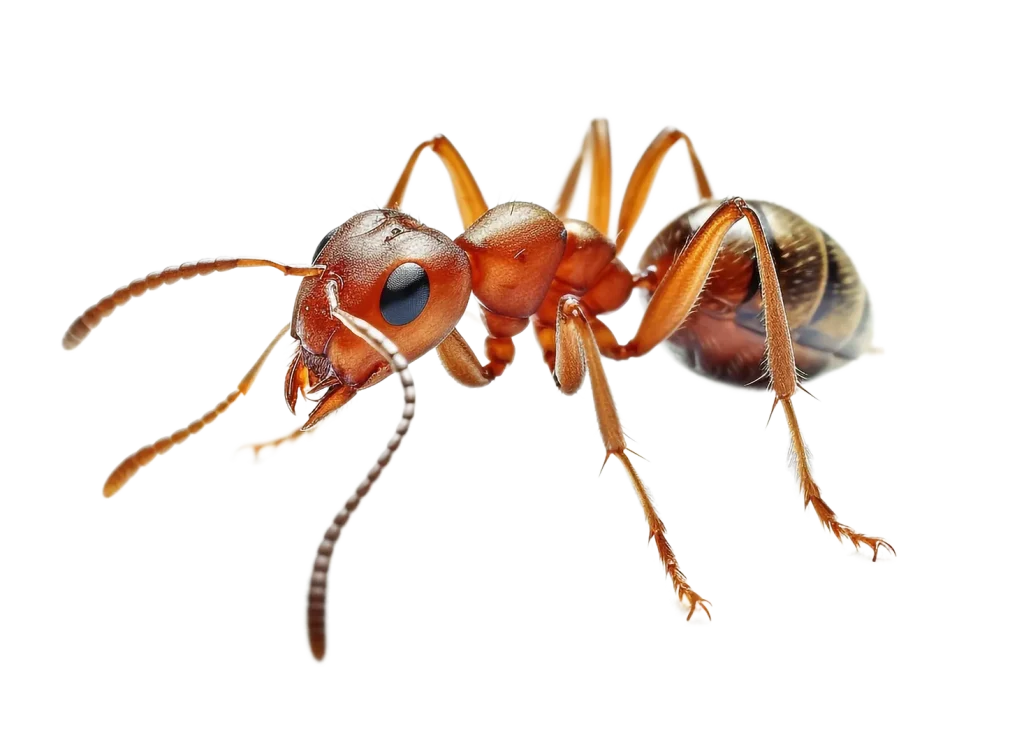
ANT
Common name: Ant
Size: 0.8 mm to 50 mm
Life Span: A few weeks to several years
Ants are among the most adaptable insects, found in nearly every environment, from dense forests to urban landscapes. They live in colonies that can range from a few dozen individuals to millions, organized into a highly structured society. Each colony has a queen responsible for laying eggs, worker ants that gather food and maintain the nest, and male ants whose only role is reproduction. Ants communicate using chemical signals called pheromones, allowing them to coordinate movement, identify food sources, and alert others to danger. They are known for their strength, capable of carrying objects many times their weight.
Some species build nests underground, while others prefer tree trunks, decaying wood, or cracks in walls. Many ants are scavengers, feeding on organic material, while some are predators or farmers, tending to aphids for their sugary secretions. Their ability to quickly adapt to changes in their surroundings makes them one of the most persistent insects. While some species, like fire ants, can deliver painful stings, most ants pose no direct harm to humans. However, their tendency to invade homes and food supplies often makes them a problem.
As pest
Ants are particularly attracted to sweet and greasy substances, often forming long trails between their nests and food sources. Once they establish a reliable food supply, colonies expand rapidly, making infestations difficult to eliminate. Some species, like carpenter ants, can cause structural damage by tunnelling through wood, while others, like fire ants, pose a health risk due to their painful stings. In agricultural settings, certain species protect plant-damaging pests such as aphids, which produce a sugary substance that ants consume.
Unlike other pests that hide or operate at night, ants are highly visible, making their presence both frustrating and unsanitary. Their small size allows them to access almost any area, from kitchen countertops to pantry shelves, contaminating food in the process. Signs of an infestation include long lines of ants, small piles of debris near nest entrances, and discarded wings from reproductive swarmers. Since ants often live in large colonies with multiple queens, eliminating a single nest may not be enough to stop the problem. Their persistence and organized behaviour make them one of the most challenging household pests to control.

How to control
Controlling ants requires a combination of sanitation, exclusion, and targeted treatments. Keeping food tightly sealed and cleaning up crumbs and spills immediately reduces their access to food. Since ants follow scent trails, wiping down surfaces with vinegar or soapy water helps disrupt their movement. Sealing cracks, gaps in walls, and openings around doors and windows prevent them from entering buildings. Baiting is an effective control method, as ants carry poisoned bait back to their colony, eliminating the source of the infestation. However, baiting requires patience, as it may take days or weeks to affect an entire colony. Insecticide sprays and dust can provide immediate relief, but they often only kill visible ants without addressing the underlying nest.
For species like carpenter ants, professional treatment may be necessary to locate and eliminate hidden nests within walls or wooden structures. Natural deterrents such as peppermint oil, citrus peels, and diatomaceous earth can help repel ants without using harsh chemicals. Since ants are highly adaptive, ongoing monitoring and preventive measures are crucial. Addressing infestations quickly and maintaining a clean environment significantly reduces the likelihood of ants returning.

